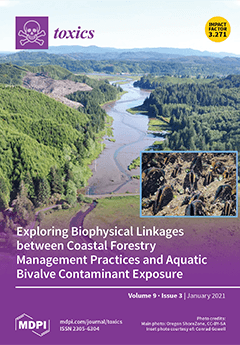Gossypol is a key anti-nutritional factor which limits the feeding application of cottonseed by-products in animal production. A 2 × 4 factorial in vitro experiment was conducted to determine the effect of gossypol addition levels of 0, 0.25, 0.5, and 0.75 mg/g on ruminal fermentation of a high-forage feed (HF, Chinese wildrye hay/corn meal = 3:2) in comparison with a low-forage feed (LF, Chinese wildrye hay/corn meal = 2:3). After 48 h of incubation, in vitro dry matter disappearance was greater in the LF than the HF group, while the cumulative gas production and asymptotic gas production were greater in the HF than the LF group (
p < 0.05). Regardless of whatever ration type was incubated, the increasing gossypol addition did not alter in vitro dry matter disappearance. The asymptotic gas production, cumulative gas production, molar percentage of CO
2 and H
2 in fermentation gases, and microbial protein in cultural fluids decreased with the increase in the gossypol addition. Conversely, the gossypol addition increased the molar percentage of CH
4, ammonia N, and total volatile fatty acid production. More than 95% of the gossypol addition disappeared after 48 h of in vitro incubation. Regardless of whatever ration type was incubated, the real-time PCR analysis showed that the gossypol addition decreased the populations of
Fibrobactersuccinogenes,
Ruminococcus albus,
Butyrivibrio fibrisolvens,
Prevotella ruminicola,
Selenomonas ruminantium, and fungi but increased
Ruminococcus flavefaciens, protozoa, and total bacteria in culture fluids in comparison with the control (
p < 0.01). Additionally, the tendency of a smaller population was observed for
R. albus,
B. fibrisolvens, and fungi with greater inclusion of gossypol, but a greater population was observed for
F. succinogenes,
R. flavefaciens,
S. ruminantium, protozoa, and total bacteria. In summary, the present results suggest that rumen microorganisms indeed presented a high ability to degrade gossypol, but there was an obvious detrimental effect of the gossypol addition on rumen fermentation by decreasing microbial activity when the gossypol inclusion exceeded 0.5 mg/g, and such inhibitory effect was more pronounced in the low-forage than the high-forage group.
Full article






